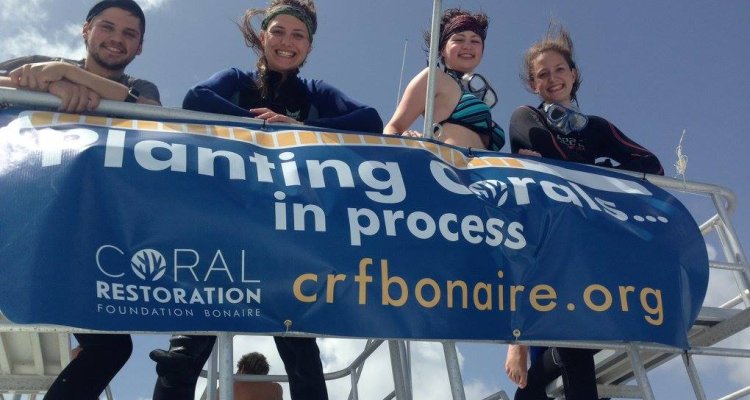
Student testimonial
Bonaire blog 1 - students MSc Biology and MSc Aquaculture and Marine Resource Management
Huge coral reefs, plenty of fish, a turtle passing by every now and then… it’s the kind of environment that I have always dreamed of working in.
Exploring the restoration of Bonaire’s coral reefs
Doing an internship with the Coral Restoration Foundation Bonaire and Wageningen Marine Research feels like realising this dream. Together with three other students, I investigate the effectivity of a project to restore the staghorn coral populations along the west coast of Bonaire. In the past, these corals were abundant in the shallow parts of the reef. Various things such as hurricanes and diseases have caused the populations to decrease dramatically. The aim of CRF Bonaire is to grow staghorn coral in so-called coral nurseries and transplant these corals to various locations along the coast once they are big enough. Besides helping the foundation with the ‘regular’ work, we will be doing our own research, that focuses on comparing the performance of transplanted coral populations to that of remaining wild populations.

Coral reef (Acropora cervicornis) in Bonaire. Photo by: Maarten Rutting.
Diver’s paradise
Many people call the island of Bonaire Diver’s paradise. During the first weeks of our internship, our main task was to get to know the underwater world – such a hard life. The coral reefs are beautiful indeed. Furthermore, there is a high fish biodiversity and the visibility never disappoints. Swimming along the steep reef drop-off or remaining shallow to look for some wild staghorn coral populations – every dive here is beautiful and teeming with life. This also provides us with a challenge, since we have to be able to recognise the marine life that is associated with staghorn coral, both fish and invertebrates. When there is no dive planned, the chance is big that at least one or two of us are leafing through the pages of reef fish or invertebrate identification guides while the others are busy preparing the tools that we require to do our measurements. For this, we pay regular visits to the local hardware megastore. Since it would be way too efficient to buy all the materials at once, we have already been there countless times, be it for buying tie-wraps, tape or PVC tubes.

Spanish hogfish (Bodianus rufus). Photo by: Maarten Rutting.
Underwater gardening
In order to be allowed to work with the corals, the four of us did a training. This included three dives in which we learned how to hang and clean corals in the nurseries, how to select corals that were ready to be transplanted and how to do the actual transplanting. Conclusion? Transplanting is like playing a good game of Tetris. Patience, care and buoyancy control are essential. Other than that, it felt mostly like I was gardening using corals instead of plants, although I might not use that many tie-wraps when working in a normal garden. Two weeks ago, there was a big event called Coralpalooza, in which at least 300 corals were transplanted all in the same day. We had the privilege to join the boat to Klein Bonaire and the subsequent restoration sites to watch how skilled divers handled the corals and help them wherever we could. This was definitely a nice addition to the training and a good way to get to know the people from CRF Bonaire better.
Up next: the real work
After all this training, it is now time to truly start our own research under water. We are all excited to see what this new phase will bring and hope to share some of it with you in our next blog. If you would like more information about the foundation itself, you can find it all on their website, along with some exciting footage of Bonaire’s wonderful marine environment. Enjoy!
Written by: Eva Mudde
Fellow students: Maarten Rutting, Lieveke Crombach and Sarina Versteeg